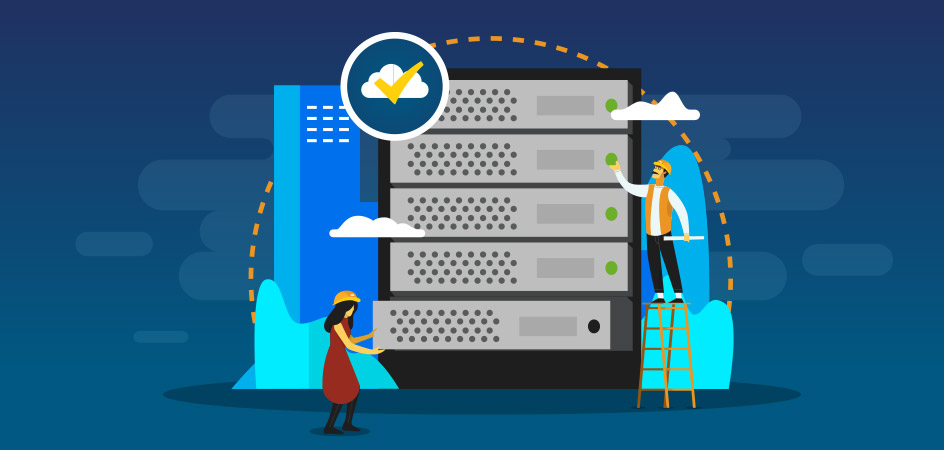
Hyper-converged Infrastructure Explained: Basics and Benefits
Posted by Walid Abou-Halloun Date: Aug 5, 2018 8:48:02 AM
Hyper-converged infrastructure is the fastest growing segment of software-defined storage. Revenues for this market are expected to reach $3.9 billion in 2019.
In 2017, hyper-converged infrastructure saw a surge in popularity, not just in data centers, but all across the IT industry.
What exactly is hyper-converged infrastructure? And what are the benefits of switching to this software-defined storage system?
Read on to learn more about hyper-converged infrastructure.
The Problem with the Previous Solution
Storage needs have grown rapidly and the result is that data centers are now a hodgepodge of different technologies.
When IT departments need new storage, they compare the cost and storage capacities of all the technologies on the market. Because of this, data centers reached a point where IT administrators are struggling to keep their heads above water.
They needed to manage a combined system of hypervisors, networking, and storage technologies—and this kind of mixed technology system isn’t efficient.
Firstly, this combination of technologies leads to system fragmentation that causes endless debates about whether it’s better to improve the older systems or move to the new ones.
Furthermore, finding people who have a complete skillset of new and old technologies is not only difficult, but also very expensive.
On the other hand, companies end up hiring IT employees who do not understand the resources that each platform needs. This leads to companies using their server capacity inefficiently at a higher cost.
What is Hyper-converged Infrastructure?
Hyper convergence has the reliability, bandwidth, and scalability that businesses need to operate.
Simply put, hyper-converged infrastructure takes cloud storage to a bigger level.
When the old data center infrastructure was proving to be inefficient, developers turn to cloud storage to find a better model.
With a hyper-converged infrastructure, data centers become like personal cloud storage. However, personal cloud storage would not be able to perform at the level businesses need, so it takes the functionality of personal cloud storage and elevates it.
The Benefits of Hyper-converged Infrastructure
There are a lot of benefits to hyper convergence. If the complexity of your network diagrams makes your head spin, then it’s time to consider making the switch from an older architecture to something new.
Your Operational Costs Will Decrease
With older data center systems, there is a high startup cost once you added up the software licenses and specially trained staff. Hyper convergence, by comparison, has a much lower barrier of entry. This is because businesses only need to buy what they need now, not what they’ll need further down the line.
The way hyper convergence works is that you purchase low-cost hardware in a building block system. Your IT team can purchase new units as needed as the needs of your business grow.
This is much more cost-efficient than having to replace all of your hardware when you’ve outgrown your system. Additionally, you’re not incurring unnecessary expenses from running more capacity than you need.
You Can Hire a Smaller IT Team
When your network is composed of different resources, you need to have a specialist for each type of technology that is part of your data center. As your patchwork quilt of technologies grows, so does your IT team.
With hyper convergence, everything is combined into one system that doesn’t even need specialised knowledge. With this new system, your IT staff only need broad knowledge to apply the hyper-converged infrastructure.
Another benefit is that you and your team can take a hands-off approach to maintaining the system. This is because the management software is run by virtual machines. This software takes care of everything from storage and backup to load balancing and replication.
You Can Take Advantage of Automation
As you develop your hyper-converged data center, you will be able to take advantage of automation. This is because all the resources of the data center are under one system. Then, things like scripting options and scheduling opportunities can be automated.
Automation benefits your business and your IT team. Now, the IT team can focus on other strategies instead of trying to create processes across different technologies.
You Will Streamline Your Customer Service
Have you ever phoned customer service and explained your entire situation, only to be told that you need to be transferred? What about when this happens more than once? It’s very frustrating since you’re already dealing with something that has gone wrong.
When you adopt hyper convergence, your customers can look forward to being able to speak to one consistent customer service team as all your hyper-converged infrastructure will come from one vendor.
For your customers, the same team can provide support at any time. It doesn’t matter if it’s the initial enquiry or ongoing IT help.
As the data center operator, you also benefit from this single-vendor system. With a hyper-converged system, updates are always compatible and released across the entire system. Furthermore, your customers receive software upgrades without any intervention on your behalf.
Streamlining your dealings with customers and vendors not only makes life easier; it also saves you money on customer retention and operating costs.
You Can Rely on Improved Data Backup System
As a data center, one of the things your customers are counting on is your ability to backup and protect their data in a situation where the hardware fails. Data companies have a necessary “not if, but when” attitude when it comes to preparing for hardware failure.
With older data center systems, IT teams had to research and purchase many products to provide a data backup in the event of hardware failure. These systems were often complex and added significantly to the financial outlay required for setup.
With hyper-converged infrastructure, IT teams are no longer in charge of protecting data from hardware failures. Instead, the software is designed with a full redundancy system including backup and recovery mechanisms in place. Even better, customers benefit from these protective measures without any further costs.
You Can Enjoy Overall Better Performance
Overall, hyper-converged systems perform better than their older counterparts. For one, they are equipped with both spinning disk and solid-state storage devices which make them more versatile.
Running two types of storage devices gives them the ability to handle different types of workloads from one resource pool without losing the quality of performance.
Having two storage types is part of the data backup and protection we mentioned earlier, however, there is an additional benefit. The setup can handle many different tasks that are thrown at it. Even when running at a high capacity, the IT team doesn’t need to worry about the infrastructure reaching capacity.
Who is Using Hyper-converged Infrastructure?
The last year and a half show that hyper-converged infrastructure is rapidly being adopted. It’s not just the largest segment in its industry right now, but it’s growing, too. The technology is predicted to hit a five-year compound annual growth rate of 26.6% with a forecast revenue of $7.15 billion by 2021.
Companies understand the importance of being on the cutting-edge of technology and almost half of the companies around the world expect to see their IT budgets increase in the coming year.
So while 23% of companies worldwide have already implemented hyper-converged infrastructure, another 22% are planning on adopting the technology by the end of 2018.
What’s Next for Hyper Convergence?
Working hand-in-hand with hyper convergence is Edge computing. As attention around this new technology increases, it’s guaranteed that we’ll be seeing it on a lot of year-end “Techs to watch” lists.
Edge computing brings the system from the sky to the ground. For this system, decides are placed closer to where the information is needed to reduce the waiting time in cloud environments.
For example, consider the traffic lights on the road. In some places, there are intelligent transportation systems that are being used to manage the flow of traffic. These systems use IoT devices and sensors to gather on-the-spot data. However, this data has a limited period of usefulness.
Edge computing systems process the data at the point of collection. This is much faster than being transmitted across a network, analysed, and then downloaded.
Start Building Your IT Dream Team Today
In a few years’ time, hyper-converged infrastructure will be as common to us as cloud computing is now. But you don’t want to be behind the curve when it comes to how you store and protect your data.
Trying to put together a top-tier IT team? From cloud architect to network engineer, we can help you meet your recruiting needs across your IT infrastructure.




